View current page
...more recent posts
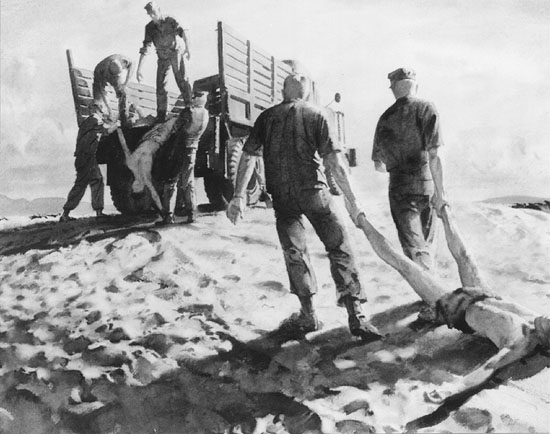
1965 watercolors by Gene Klebe. Above: Clean-Up After Marble Mountain Battle; below: Operation Market Time.
Art worlders, including many in the blogosphere, continue to give salutatory high-fives each time a new series of drawings appears by Steve Mumford, an artist who has been unironically embedded with the troops in Iraq. Carol Kino did it in the New York Times as well, this week. This page has complained (here and later here) that Mumford's a rather ham fisted draftsman and absolutely on the wrong side of the war issue. Bush has a snit because Saddam tried to kill his Daddy, the neocons seek a permanent American "footprint" in the mideast, thousands upon thousands needlessly die from American bombing and the subsequent chaos, and there's Mumford sanitizing the mess. The art world marched to stop this horror but out of friendship (or simple bewilderment) enables Mumford to do his thing.
Commenter Mr. Potts likes Mumford's work, and steers us toward this Dept. of the Navy page of sketches and paintings from the Vietnam era. (The pictures in this post come from there.) These are indeed Mumford's forerunners: official, clunky court room style art that supports the war effort--except the two images here, by Gene Klebe, actually have more punch and clarity than Mumford's washy drawings. But the art world wouldn't fete the artists on the Navy's site and give them shows at White Columns. They'd be seen as "mere illustrators" who wouldn't get past the velvet rope.
In the Times article, Mumford says he went to Iraq convinced it was a mistake (which you would never know from his bland sketches) but now having contact with ordinary Iraqis and seeing their joy at the ending of the horrible Saddam years has him "on the fence." He's more than that, as his writings clearly show--Karl Rove could have ghostwritten the diaries. Reading them gives you a good sense of the mental contortions our troops have to go through to convince themselves they're on the side of the angels. But the unreconstructed colonial, who thinks it's his right to document and help these sweet, misguided people, often shows his face. The latest diary veers between the narcissistic and the maudlin, and sometimes you get the feeling that Mumford is over there as a thrill seeker, playing Army in a country he has no ultimate stake in. Still weighing whether to post excerpts--they make him sound pretty bad, and he's really just politically naive.
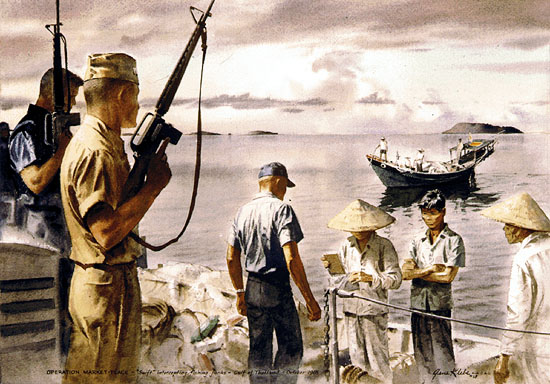
Below: Duncan Hannah, from a show last spring at JG Contemporary/James Graham & Sons, New York, a painting based on one of the photos in Antonioni's Blowup. Hannah is of the '80s appropriation generation but never got his due as a theoretical painter--he's too low key and modest in his artful (and oddly affectless) borrowings and montagings of old magazine illustrations and movie photos. Nevertheless he keeps working and showing, a kind of rootless, misunderstood existence in the uptown-style painting galleries. He has his cult, but deserves broader appreciation.
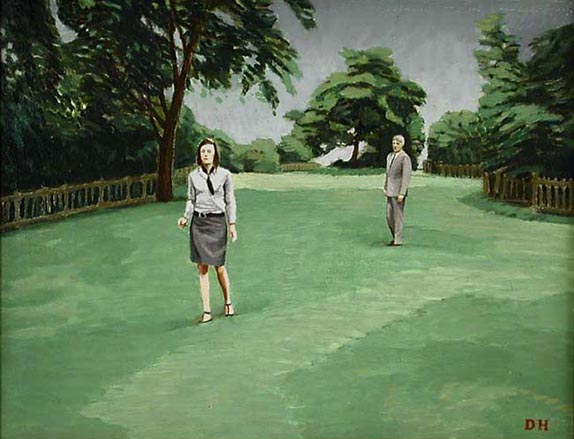
Tonight I'm going to hear jenghizkhan performing live at The Psychasthenia Society, Galapagos Art Space, 70 North 6th Street Williamsburg, Brooklyn (between Wythe and Kent). I did an interview with him here, and am curious to hear the new music he's been writing. He goes on first at 10 pm. It's free.
Tomorrow night (Thursday, December 16, 6 pm) Cory Arcangel is speaking up at Columbia U in a series called "Open Source Culture: Intellectual Property, Technology, and the Arts." Previous speakers included Joy Garnett and Jon Ippolito. Cory is strongly advised to phone this lecture in from an undisclosed location.
Everything foul about the current copyright regime is summed up in Eric Fensler doing slam-bang satirical mashups of GI Joe PSAs and getting a letter from Hasbro's lawyers telling him to remove them from his website. Hmmm, just revisited my earlier post on "Making art in the age of abusive copyright enforcement" and find that only two options for artists are still viable. Here's what I recommended six months ago to avoid the lawyer letters:
1. Stay poor. The humorless twit who sued Jeff Koons over that "string of puppies" photo would never have done it if Koons hadn't been an "art star." Very few people sue to make a point (except RIAA); it's too expensive. [Whoops, post-Fensler this now seems excessively optimistic--strike this one.]2. Record live versions of other people's songs, or song fragments, for the sole purpose of sampling them--you avoid the "master recording" fee for the sample and only have to pay the "publication" fee. Just kidding: this is actually done by the big-bucks hiphop performers, as described in the Chuck D/Hank Shocklee interview, but it sounds fake as hell--essentially having a lawyer as a creative partner.
3. Stay several steps ahead of the shysters by mutating the sounds so they're virtually untraceable. A lot of drum and bass producers do this. You don't get that bang of recognition ("Oh that's Richard Dawson in Running Man!") but the texture of the sound is yours to play with. [Dicey after the 100 Miles and Runnin case, which applies to snippets of samples. Strike this one, too.]
4. Make completely original art. No more samples, no more collage, it's back to the Modernist dictate "make it new." It's always possible you heard or saw something subconsciously that crept into your work and could get you sued, but creativity isn't just about mixing up other people's stuff. (Dumb, I know; I just put it in in case Jed Perl stumbled across the page).
I missed La Superette this month, the annual artist mega-merch table event organized in New York by Tali Hinkis, and I'm sad because I would have been interested in (among other things) these Perler Bead floppies by Kate Pemberton:
More Perler iron-and-fuse bead work is depicted here in my writeup of the Mondo Mondo Trading Post. I found the Pemberton image via Your door to explore, a good collection of links to the kind of komputer kraft stuff I periodically post about here (including links to here, but that's not the only reason I mention it, and also some typical dumb LiveJournal fodder, like "what type of _______ are you" quizzes). I also learned there about Mr. Ministeck (Norbert Bayer) who makes pixeled images with Ministeck, another brand of fuse beads first made in Bavaria in the 70s. I had seen his Pac Man image but didn't know what it was.
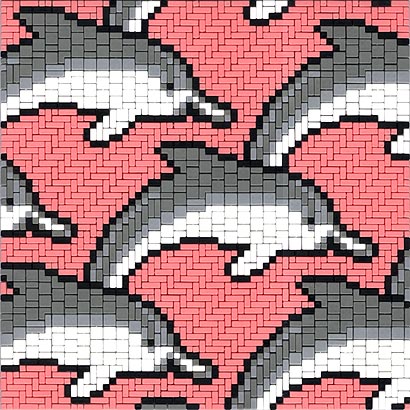
Awesome. Related topics of interest from the blog vault:
Joe Beuckman bead works; Jason's Pokemon bead designs drawn in MSPaint.
Bill Davenport needlepoints 1
Bill Davenport needlepoints 2
And one more relevant item from La Superette, by FLUORESCENT F and SISTAZ 4EVER (Frankie & Katie Martin):
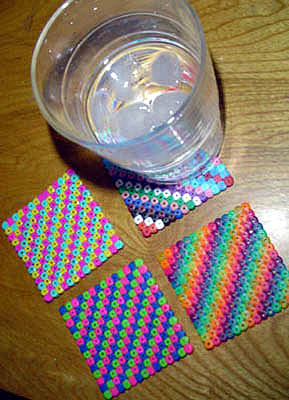
Ni-i-ice. Just noticed this: the generous folks at Hasbro sent Eric Fensler a cease and desist letter telling him to remove his hilarious, remixed GI Joe public service videos from his website. Citing copyright and the usual crap. Millions have enjoyed these vids but we can't have people laughing at GI Joe, can we?
Don't know if this video, opening at Momenta Art this Friday, December 17, 6-9 pm, is good, but the description from the press release cracks me up:
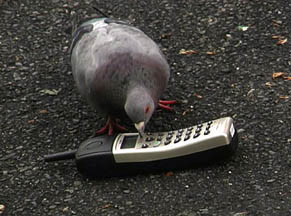
"Lisa DiLillo’s video and photographic work focuses on the peculiar interactions that take place between human constructs and other life forms. In her video piece This Call May be Monitored, a segment of a larger body of work entitled "Encounters," a group of pigeons gather around a lost cell phone in an urban park. As they randomly peck at the keys, they inadvertently dial a corporation that employs a voice recognition system. This results in a series of misinterpretations and technological cul-de-sacs. The fleeting sense of triumph over a technology meant to convenience the corporation over the individual quickly dissipates as the viewer recognizes that the corporation itself is not affected by this encounter whatsoever."
The description of the other artist's show is Marxism 101: "Exquisitely crafted and making clear reference to post-minimalism, Simone Leigh questions the bourgeois strategy of that formalist movement, which favored materiality over cultural meaning. The titles of these works mirror this formal disconnect, referencing the “Cake Walk” dance that was adopted by white, southern society. The cake walk was actually created by slaves to mock the strut of their masters. But just as the slave masters did not care what the dance was meant to emulate, the essentialism of minimalist and post-minimalist masters did not take into account either the national origin of their raw materials or the ethnocentric grounding of many forms considered to be essential or aesthetically pure. By remaining conscious of the economic and social connotations of her sculptural forms, Leigh not only evokes an underlying history of colonialism, but she also reminds us of its presence in an art world that continues to coolly reject any reminders of the world outside of its self. [Actually the post-Minimalists, principally Eva Hesse and Richard Serra, were edging away from the "de-cultured," machine-tooled art of Judd, etc. towards what Robt. Atkins calls "the embellished" and what I'd additionally call "being-in-the-world." Hesse "feminized" machine-tooled art with disposable, organic elements, and Serra's first works were basically earthworks. I don't think any great artists, Minimal, post-Minimal, or even the AbEx'rs, were pure formalists. Only an idiot talks about art solely in terms of color, symmetry, etc.]
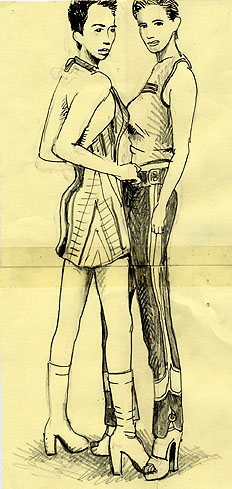
Those reading this weblog outside New York should know that people in this city hate Rudolph Giuliani. Before 9/11/01 he was a nudzh whose tenure was memorable mainly for the bullying of sidewalk vendors and people dancing in bars, and racism. His current standing derives from looking televisually calm on 9/11 while Bush flew cluelessly around the country--it's an act that played well outside the five boroughs but no one here was impressed, because we know what a camera hog he is. As Al Sharpton said shortly after that horrible day, "The people didn't come together because of the mayor, they came together because of the victims. They would have come together if Bozo had been mayor." (Some people thought that was "too much" at the time.)
So imagine a collective "aah" of pleasure this week as Giuliani's personal pick for Fatherland Security, Bernard Kerik, went down in flames amid a host of accusations of...irregularities. Here's what the New York Press said a few days ago, when it looked liked Kerik would sail through confirmation hearings with minimum press scrutiny:
But it needs to be said: Not only is Kerik unqualified for the Homeland Security post, the politics behind his candidacy are built upon a myth—the myth of Rudy Giuliani and 9/11. Sustaining this myth requires keeping a few facts from bubbling up the memory hole, such as: Rudy's headless chicken act on the morning of the attacks; his idiotic decision to place the city's emergency management center—and illegal fuel tanks—in WTC 7; his prompt melting of the wreckage, thus destroying the evidence from the biggest crime scene in American history; and his baffling negligence in preparing for a likely second attack on the towers following the Trade Center bombing of 1993, as evidenced by the lack of coordinated planning between agencies and widespread equipment dysfunction on 9/11.
The Rudy-9/11 myth is crucial to Kerik's nomination, because without this myth there is no Rudy the National Player, and without Rudy the National Player there is no nomination of brusque outsider Bernie Kerik to a major cabinet post in Washington. Rudy has always been upfront about his hand in Kerik's rise from pony-tailed narc to NYPD chief. And just as it was Rudy—and 9/11—that allowed Kerik to enrich himself in the terror biz, it was Rudy who put Kerik's name on President Bush's lips last week.
